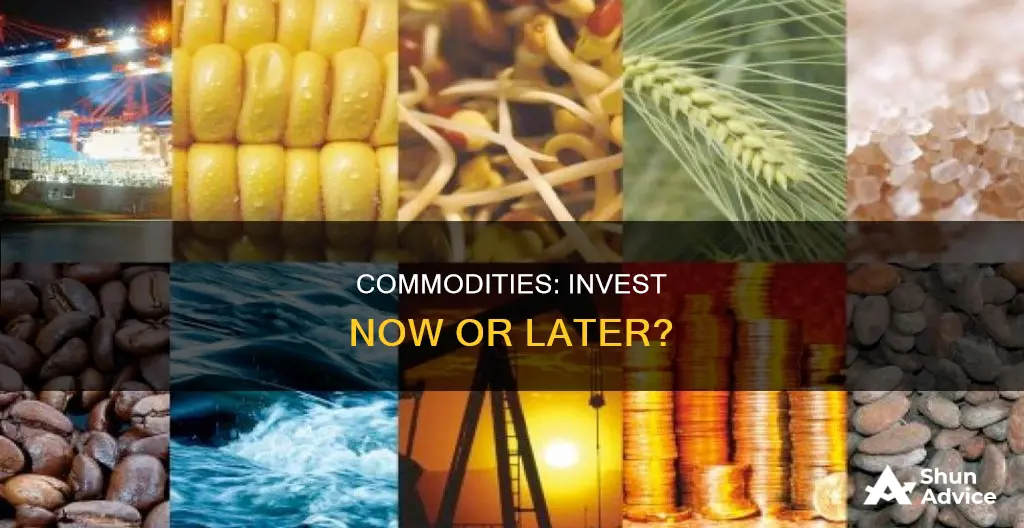
Investing in commodities can be a great way to diversify your portfolio and hedge against inflation. Commodities are raw materials that are either consumed directly or used to produce other goods. They can include precious metals, oil, agricultural products, and more. While commodities can be a volatile investment, they often have a low correlation with traditional investments like stocks and bonds, which can help reduce risk and smooth out returns.
There are several ways to invest in commodities, such as purchasing physical goods like gold, investing in ETFs that track commodity indexes, or buying stocks of commodity-related businesses. It's important to understand the risks involved, as commodity prices can be impacted by various factors such as supply and demand, weather conditions, and geopolitical events.
| Characteristics | Values |
|---|---|
| Should I invest in commodities right now? | It depends on your risk tolerance and investment goals. Commodities can be a good way to diversify your portfolio and hedge against inflation, but they are also volatile and may not be suitable for long-term investment strategies. |
| Types of commodities | Agricultural (e.g. coffee, corn, sugar, soybeans, wheat), energy (e.g. oil, natural gas), metals (e.g. gold, silver, copper), livestock (e.g. cattle, hogs) |
| How to invest in commodities | You can invest in commodities by purchasing physical goods (e.g. gold), buying stocks of commodity-producing companies, investing in ETFs that track commodity indexes, or using futures contracts. |
| Benefits of investing in commodities | Commodities can offer inflation protection, low correlation to other assets, and a hedge against other investments. |
| Risks of investing in commodities | Volatility, speculation, exposure to geopolitical events and weather conditions, concentration in a single asset |
What You'll Learn

Commodities as a hedge against inflation
Commodities are an appealing prospect for investors looking to diversify their portfolios. Commodities prices often follow inflation, and as a result, they can provide a defence against the impact of rising prices. This makes commodities a good hedge against inflation.
Commodities are typically produced or extracted products, often natural resources or agricultural goods, that are used as inputs in other processes. They are interchangeable goods, and by that broad definition, a host of products could potentially qualify as commodities. Investors tend to take a more specific view, most often referring to a select group of basic goods that are in demand across the globe. Many commodities that investors focus on are raw materials for manufactured finished goods.
Commodities can be divided into two categories: hard and soft. Hard commodities require mining or drilling, such as metals like gold, copper, and aluminum, and energy products like crude oil, natural gas, and unleaded gasoline. Soft commodities refer to things that are grown or ranched, such as corn, wheat, soybeans, and cattle.
Commodities are a good hedge against inflation because they are often used as inputs in manufacturing processes or consumed by households and businesses. As a result, when prices rise in general, so do the prices of commodities. For example, gold has traditionally been the exemplar inflation-hedge commodity.
There are several ways to invest in commodities, from physical ownership to mutual funds to alternative investments such as hedge funds. One way to gain exposure to commodities is through funds linked to indexes. Another way is to use a commodities trading advisor to buy futures, options, and swaps.
It is recommended that investors allocate around 5-15% of their portfolio to commodities. Commodities have a history of low long-term returns and high volatility, so investors may want to keep any allocations to commodities relatively small and well-diversified.
Retirement Planning: When Do People Start?
You may want to see also

The volatility of commodities
Commodities are goods that are more or less uniform in quality and utility, regardless of their source. They are often natural resources or agricultural goods, and they are used as inputs in other processes. Commodities are produced or extracted, and they can be classified into two categories: hard and soft.
Hard commodities are mined or drilled, such as metals like gold, copper, and aluminum, and energy products like crude oil, natural gas, and unleaded gasoline. Soft commodities are things that are grown or ranched, such as corn, wheat, soybeans, and cattle.
Commodities are appealing to investors looking to diversify their portfolios. They often follow inflation, and they can act as a hedge against it. However, returns on commodities can be unpredictable, and they are considered a volatile asset class.
Factors Affecting Volatility
The degree of variation, not the level of prices, defines a volatile market. Volatility is a result of the underlying supply and demand characteristics of the market. High levels of volatility reflect extraordinary characteristics of supply and/or demand.
For example, during the winter heating season, natural gas demand often surges unexpectedly, while supply has less flexibility. This creates a situation where any change in market fundamentals will result in large swings in price.
Other factors that affect volatility include weather changes, production and imports, storage levels, and delivery constraints. Weather, in particular, can cause short-term demand fluctuations. For instance, during cold weather, demand for natural gas for heating purposes often increases, while a warm spell during winter can depress prices.
Impact of Volatility
Volatility provides a measure of price uncertainty in markets. When volatility rises, firms may delay investment decisions or increase their risk management activities, increasing the costs of supplying and consuming gas.
Volatile commodity prices can also pose economic challenges, especially for commodity exporters. For example, higher volatility in commodity prices may induce greater volatility in government finances, leading to stop-start public investment and negatively impacting physical and human capital investment.
Additionally, volatility in commodity prices can increase the volatility of domestic inflation over the medium term. This can occur as greater volatility in the price of imported goods passes through to domestic prices, resulting in more volatile consumer inflation.
Managing Volatility
To manage volatility, investors should consider keeping allocations to commodities relatively small and well-diversified. Additionally, investing in commodities that tend to be more stable, such as gold, can help buffer against volatility.
Commodities can be a valuable addition to a portfolio, but their volatile nature should be carefully considered. By understanding the factors that drive volatility and its potential impacts, investors can make more informed decisions about investing in commodities.
Songs: The New Investment Avenue
You may want to see also

Supply and demand
The decision to invest in commodities depends on several factors, including your risk tolerance, investment objectives, and market conditions. One key consideration is the dynamic between supply and demand, which can significantly impact commodity prices and investment returns. Here's an overview of how supply and demand factors affect the commodity market:
Commodity industries are highly sensitive to supply and demand fluctuations. In these industries, the product is typically standardised, such as wheat or cattle. Producers have limited pricing power, and in normal market conditions, they are price takers rather than price makers. Therefore, any imbalances in supply and demand can cause significant price movements. For example, a decrease in supply or an increase in demand can lead to higher prices, while an increase in supply or a decrease in demand can cause prices to fall. Understanding the supply-demand dynamics and anticipating future shifts is crucial for investing in commodities.
Price Spikes and Declines:
Commodity prices tend to be volatile and can experience sharp spikes or declines in response to changes in supply and demand. For instance, the COVID-19 pandemic caused a slowdown in lumber production, leading to a supply shortage and a surge in lumber prices in 2021. However, as supply recovered and the market normalised, lumber prices declined again. Such price spikes are often short-lived as high prices incentivise suppliers to increase production, eventually leading to a correction in prices.
Lowest Cost Producers Win:
In commodity industries, companies with the lowest production costs tend to be the most successful. They can generate higher profits per unit, even if commodity prices decline. On the other hand, high-cost producers are more vulnerable to price fluctuations and may struggle to remain profitable if prices fall. Therefore, when investing in commodity producers, it's essential to consider their cost structure and competitive position.
Impact of Geopolitical Events:
Commodity prices are susceptible to geopolitical events and global economic conditions. For example, the Russia-Ukraine conflict impacted the prices of energy commodities like oil and natural gas. Similarly, weather patterns can affect the supply of agricultural commodities, influencing their prices. These external factors can create significant price volatility and impact investment returns.
Speculative Nature of Commodities:
Investing in commodities involves speculation on the future price movements of the underlying asset. Unlike other investments, commodities do not generate underlying cash flows, and their performance depends primarily on supply and demand dynamics. This speculative nature of commodities makes them riskier than traditional investments, and investors must carefully consider their risk tolerance before investing.
Training Investments: Why Bother?
You may want to see also

Investing in physical commodities
Commodities are raw materials that are either used directly, such as food, or used to produce another product. Oil, for example, is a widely traded commodity that is used in the production of many goods and services.
There are several types of commodities, including precious metals (like gold, silver, and platinum), energy sources (like oil and natural gas), and soft commodities (like grains, livestock, and coffee).
One of the biggest benefits of investing in physical commodities is that they can protect investors against the effects of inflation. During periods of high inflation, demand for commodities tends to be high, which pushes up prices. Commodities can also be a good hedge against a decline in the base currency.
Another advantage of investing in physical commodities is the potential to maximize returns. Global demand for commodities is strong, which can have a positive impact on the stocks of companies that deal specifically with commodities.
However, it is important to note that commodities tend to be much more volatile than other types of investments, especially when tracking a single commodity or a specific sector of the economy.
- Buying bullion or coins: Investors can purchase bullion bars or coins made of precious metals such as gold or silver. This option requires paying for storage in a safe place, such as a safety deposit box or a vault.
- Futures contracts: A futures contract is an agreement to buy or sell a commodity at a specific price and date. This method can be highly volatile and requires a good deal of capital and knowledge, so it may not be suitable for novice investors.
- Stocks and ETFs: Investors can also invest in stocks or exchange-traded funds (ETFs) of companies that produce or explore commodities. For example, investing in gold mining companies or oil producers.
When considering investing in physical commodities, it is essential to understand the risks involved. These include volatility, the speculative nature of trading, geopolitical events, weather conditions, and concentration in a single asset.
Additionally, when investing in physical commodities, it is crucial to do your research and consult with a financial professional to ensure that you understand the specific factors driving the supply and demand of each commodity.
SIPs: Invest Now or Later?
You may want to see also

Commodity futures contracts
Commodity futures are most often traded by commercial enterprises that depend on commodities for their business activities. For example, a cereal company might buy wheat futures to secure prices, while an airline might purchase energy futures.
Commodity futures can be used to hedge or protect an investment position. They can also be used to speculate on the directional move of the underlying asset, taking either a long or short position, using leverage. The high degree of leverage used with commodity futures can amplify gains and losses.
There are risks involved with commodity futures contracts. Trading in these contracts can be very risky for inexperienced investors. If a futures contract position is losing money, the broker can initiate a margin call, demanding additional funds to shore up the account.
Before investing in commodity futures, it is important to do due diligence and understand the obligations and risks involved.
Invest in Yourself: Your Greatest Asset
You may want to see also
Frequently asked questions
Commodities are raw materials or agricultural products that are either consumed directly or used to produce other goods. Examples include gold, oil, wheat, and copper.
Commodities can help investors diversify their portfolios and hedge against inflation. They often have low correlations with traditional investments such as stocks and bonds, which can smooth out returns and reduce risk. Additionally, commodity prices tend to rise during periods of high inflation.
Commodity prices can be extremely volatile and unpredictable, making them a speculative investment. They are also subject to geopolitical events, weather conditions, and supply and demand imbalances, which can further increase price fluctuations.
There are several ways to invest in commodities, including purchasing physical goods (such as gold bars or bullion) , investing in commodity futures contracts, buying stocks of commodity-producing companies, or investing in exchange-traded funds (ETFs) that track specific commodity indexes.
Some popular commodities to invest in include agricultural products (such as coffee, corn, wheat), energy sources (such as oil and natural gas), metals (such as gold, silver, copper), and livestock (such as cattle and hogs).







